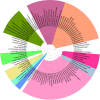Investigating Additive and Replacing Horizontal Gene Transfers Using Phylogenies and Whole Genomes
- PMID: 39163267
- PMCID: PMC11375855
- DOI: 10.1093/gbe/evae180
Investigating Additive and Replacing Horizontal Gene Transfers Using Phylogenies and Whole Genomes
Abstract
Horizontal gene transfer (HGT) is fundamental to microbial evolution and adaptation. When a gene is horizontally transferred, it may either add itself as a new gene to the recipient genome (possibly displacing nonhomologous genes) or replace an existing homologous gene. Currently, studies do not usually distinguish between "additive" and "replacing" HGTs, and their relative frequencies, integration mechanisms, and specific roles in microbial evolution are poorly understood. In this work, we develop a novel computational framework for large-scale classification of HGTs as either additive or replacing. Our framework leverages recently developed phylogenetic approaches for HGT detection and classifies HGTs inferred between terminal edges based on gene orderings along genomes and phylogenetic relationships between the microbial species under consideration. The resulting method, called DART, is highly customizable and scalable and can classify a large fraction of inferred HGTs with high confidence and statistical support. Our application of DART to a large dataset of thousands of gene families from 103 Aeromonas genomes provides insights into the relative frequencies, functional biases, and integration mechanisms of additive and replacing HGTs. Among other results, we find that (i) the relative frequency of additive HGT increases with increasing phylogenetic distance, (ii) replacing HGT dominates at shorter phylogenetic distances, (iii) additive and replacing HGTs have strikingly different functional profiles, (iv) homologous recombination in flanking regions of a novel gene may be a frequent integration mechanism for additive HGT, and (v) phages and mobile genetic elements likely play an important role in facilitating additive HGT.
Keywords: Aeromonas; additive transfer; genome evolution; horizontal gene transfer; prokaryotes; replacing transfer.
© The Author(s) 2024. Published by Oxford University Press on behalf of Society for Molecular Biology and Evolution.
Figures






References
MeSH terms
Grants and funding
LinkOut - more resources
Full Text Sources

